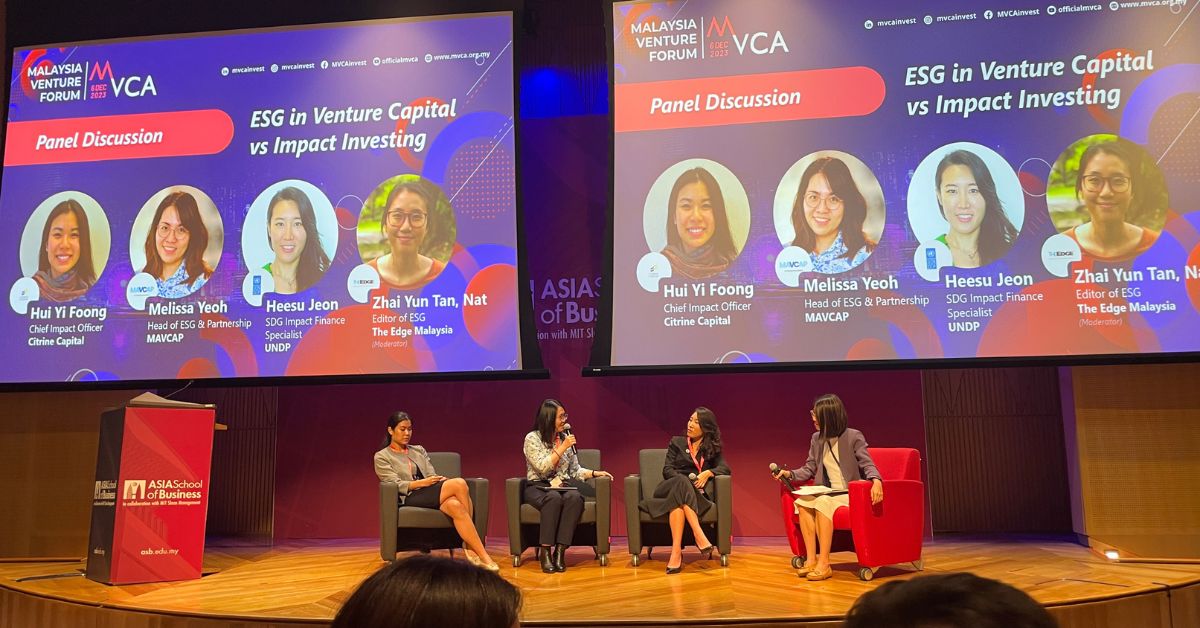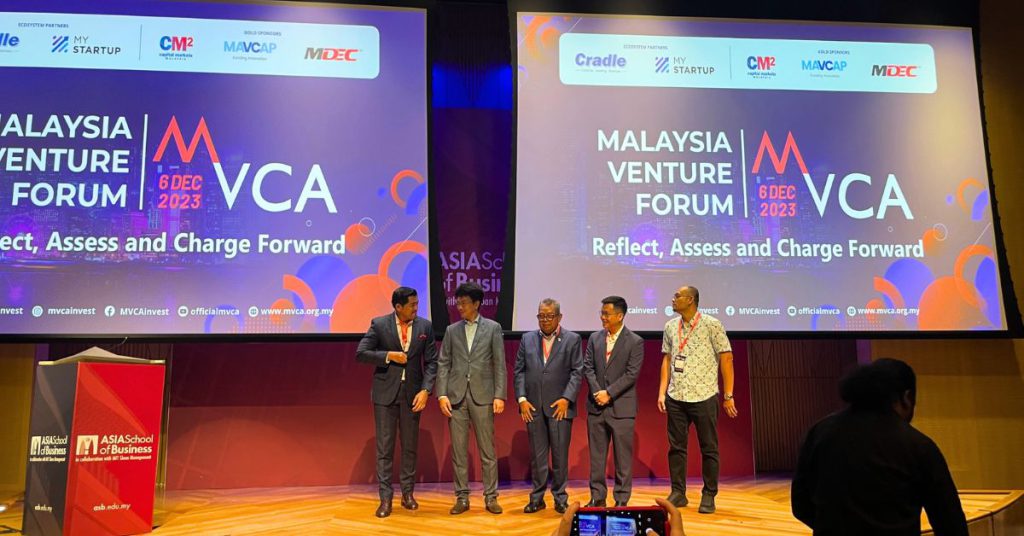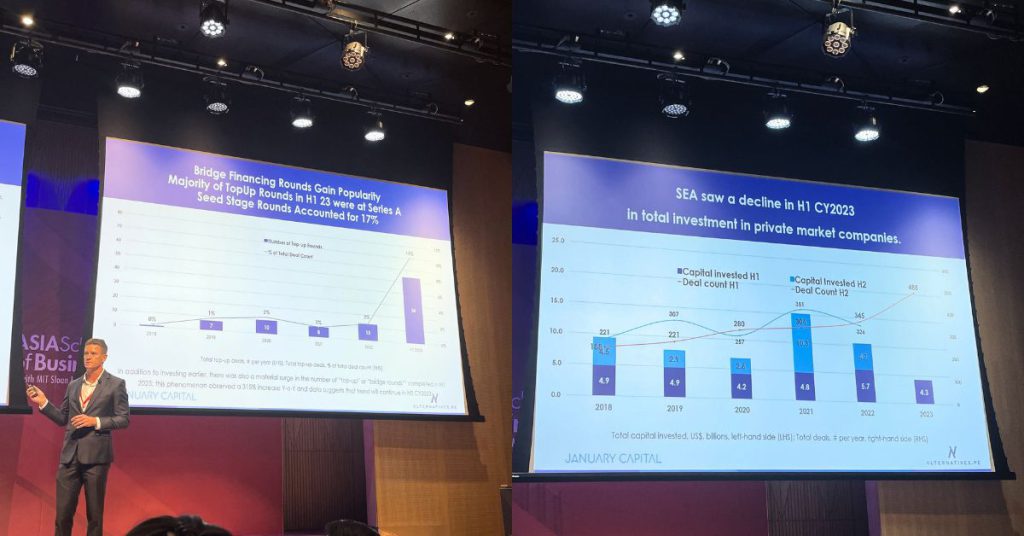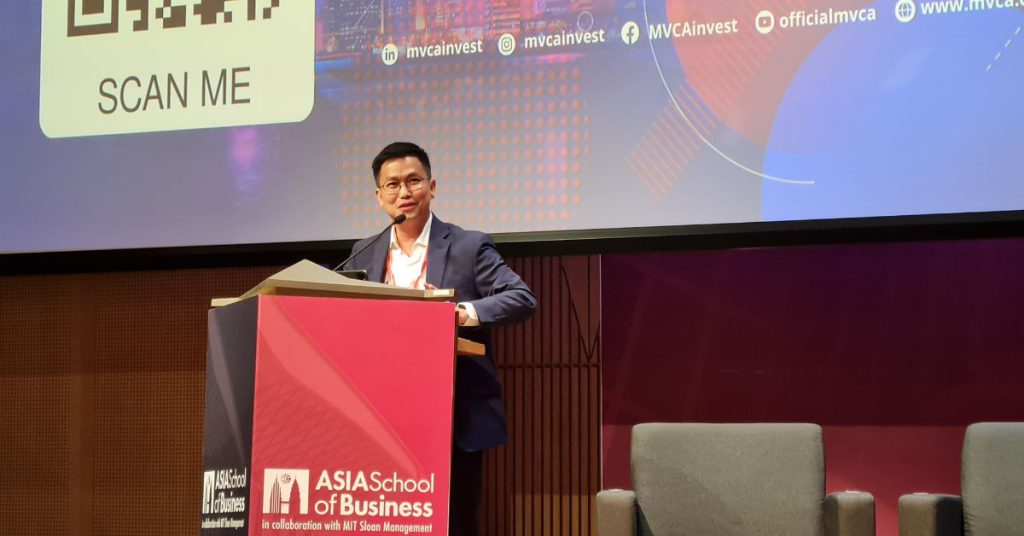Here are 6 funding trend predictions for 2024, based on what we heard at M’sia Venture Forum
Here are some funding trends we predict for 2024 based on what we observed at the Malaysia Venture Forum 2023 where investors spoke.

On December 6, we attended the Malaysia Venture Forum by the Malaysia Venture Capital Association (MVCA).
Held at the Asia School of Business, we saw venture capitalists, angel investors, and startup founders milling about. Some familiar attendees and panelists included 500 Global’s Khailee Ng, CEO of MAVCAP Shahril Anas Hasan Aziz, Jamaludin Bujang of Gobi Partners, and so many more.
 Image Credit: Vulcan Post
Image Credit: Vulcan PostThroughout the day, we picked up on many industry insights and trends. Through our observations, here’s what investors are anticipating for next year’s startup landscape.
1. More deals, but smaller cheques
During a keynote speech by Jason Edwards, the founder of Alternatives.pe, he pointed out some funding statistics from H1 of 2023.
Alternatives.pe is a platform that seeks to provide accurate and complete private market data in Southeast Asia and Australia.
Lately, there has been a lot of talk that funding has slowed down in Malaysia and Southeast Asia. A report by Google, Temasek, and Bain & Company highlighted that funding has declined across industries in Malaysia, slowing to a six-year low.
He also shared that during the pandemic, funding volumes had increased greatly, but that was an anomaly. Because of that, it appears that funding seems to be declining now. But he claimed that funding conditions are actually on the rise compared to pre-COVID levels.
That said, according to Jason’s data, SEA indeed has seen a decline in H1 of 2023 in terms of capital funded. However, the data from Alternatives.pe shows that deal counts have increased across sectors. That means deals are happening, it’s just that the average deal sizes are smaller.
 Image Credit: Vulcan Post
Image Credit: Vulcan PostSo, going into 2024, it seems that deals with huge funding amounts might not be as common, but there may be more to go around for everyone.
2. More bridge rounds to close the valuation gap
In the same keynote, Jason also pointed out that bridge financing rounds in the region have gained popularity.
These bridge rounds are also known as “top-up” or “extension” rounds, and is a type of funding used to extend the runway of a startup until it can raise the next funding round.
There may be a variety of reasons for this. It’s understood that startup valuations skyrocketed during the pandemic. As such, now it feels like valuations have lowered (or come back to pre-pandemic times).
Jason pointed out that nowadays, even those who are doing well and have doubled the revenue are having a hard time getting a “flat round”, which refers to a round where valuation remains the same as the previous round.
Thus, some startups may opt for a bridge round so that the next round can be a considerable and meaningful step up.
As such, Jason believes that bridge rounds will continue being common in the coming year.
3. Heightened focus on ESG & impact investing
Just spend some time around investors and you’ll know that environmental, social, and governance (ESG) considerations has become a key investment factor for many these days
In case you need a refresher on what ESG means, here’s an explainer article all about it.
 Image Credit: Vulcan Post
Image Credit: Vulcan PostGoing into 2024, it seems like conversations around ESG will not be slowing down anytime soon. At the Malaysia Venture Forum, there was a whole panel about ESG and impact investing. You can read more about what impact investing is here.
Going forward, we also caught wind of various toolkits and frameworks for impact investing that will be coming out in the following year, so those resources will definitely be necessary in helping with the measurability of impact and ESG efforts.
We also heard conversations around the increasing awareness of blended finance.
According to the World Economic Forum, blended finance is the strategic use of public finance for the mobilisation of additional private finance towards sustainable development in developing countries.
The purpose is to attract commercial capital towards projects that contribute to sustainable development, while providing financial returns to investors. Basically, blended finance is when funding from, say, the government helps unlock funding for investments in areas that aren’t well funded.
In a way, funds such as Khazanah Nasional’s Dana Impak, which is their impact fund, is doing that. For 2024, it was announced that RM600 million will be allocated to this fund to spur economic growth and create opportunities for rural, suburban, and underserved communities.
With that, we’re expecting (and hoping) to see more impact investments in 2024.
4. Top industries to pay attention to include AI, food security, and more
At this point, it’s clear that AI is not just a temporary fad, but rather the direction that the world will be moving in.
As cost for the technology lowers and ubiquity increases, AI will become more than just a productivity tool. With that in mind, investors may be looking at entrepreneurs who can tap into that and look at AI beyond just a performance tool.
During the various talks, these were some of the other industries that were pinpointed. It seems that eyes will be on businesses that tackle these sectors or issues:
Logistics Food security Circular economy Energy transition Regional growthThere were some who also believe that investors may want to go back to some “tried-and-tested” and less risky industries such as software-as-a-service (SaaS) or fintech startups, though, especially with how poorly more nascent industries like crypto have performed.
5. Startups to utilise different methods of funding more
During the Malaysia Venture Forum, we saw a lot of conversations around not just venture capital funding but equity crowdfunding (ECF), venture debt financing, peer-to-peer (P2P) financing and more.
Of course, these options have been around for a long time, but it feels like 2024 might just see more startups moving away from the raising of funds from venture capital firms.
Crowdfunding may become more popular next year, too. One big concern around ECF is that the valuation on ECF platforms might not always be accepted by venture capital firms, making it tricky for ECF-funded startups to later on get the funding they need from VCs.
However, at Malaysia Venture Forum, we heard from MyStartr’s COO who shared that the company is actually organising a townhall to further discuss this concern and will be putting measures in place to ensure the valuations of companies on the platform are well-advised and reasonable.
6. It’s not just about monetary capital now, but knowledge and network capital
Of course, it’s been known that entrepreneurs should do their due diligence when it comes to fundraising with venture capital firms and determine whether they’d be a good fit to begin with.
Yet, based on the conversations we’ve heard during not just the Malaysia Venture Forum but throughout the whole Startup Week Malaysia, which the forum was a part of, we think that now more than ever entrepreneurs are more selective when it comes to the investor they want.
We heard some corporate venture capital firms share how startups now not only want financial capital, but also knowledge and networking resources.
 Image Credit: Vulcan Post
Image Credit: Vulcan PostSimilarly, it seems that venture capital firms want founders who have the right networks and teams. Investors appear to want people with a global task force, or at least the capacity to expand regionally.
It’s certainly not the first time this year we’ve heard that investors want entrepreneurs who think about global expansion from the get go.
So, we expect to see Malaysian startups being more cognisant about regional dynamics and prepare go-to-market strategies and global roadmaps when approaching investors in 2024. Likewise, startups may also want investors who have the right resources to get them there.
All in all, 2024 looks to be a year brimming with potential. Here at Vulcan Post, we’ll be monitoring the startup landscape, so be sure to stay tuned to our platform for funding news, industry insights, and more.
Read other articles we’ve written about funding here.Featured Image Credit: Vulcan Post

 MikeTyes
MikeTyes 































